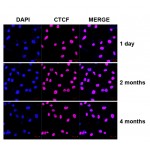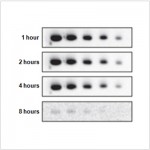| Reactivity: | Human, Mouse, Rat |
| Applications: | WB, IHC, ELISA |
| Host Species: | Rabbit |
| Isotype: | IgG |
| Clonality: | Polyclonal antibody |
| Gene Name: | potassium inwardly rectifying channel subfamily J member 4 |
| Gene Symbol: | KCNJ4 |
| Synonyms: | HIR; HRK1; IRK3; HIRK2; IRK-3; Kir2.3; KCNJ4 |
| Gene ID: | 3761 |
| UniProt ID: | P48050 |
| Immunogen: | A synthetic peptide corresponding to a sequence within amino acids 50-150 of human KCNJ4 (NP_004972.1). |
| Dilution: | WB 1:500-1:2000; IHC 1:50-1:200 |
| Purification Method: | Affinity purification |
| Concentration: | 0.60 mg/ml |
| Buffer: | PBS with 0.02% sodium azide, 50% glycerol, pH7.3. |
| Storage: | Store at -20°C. Avoid freeze/thaw cycles. |
| Documents: | Manual-KCNJ4 antibody |
Background
Several different potassium channels are known to be involved with electrical signaling in the nervous system. One class is activated by depolarization whereas a second class is not. The latter are referred to as inwardly rectifying K+ channels, and they have a greater tendency to allow potassium to flow into the cell rather than out of it. This asymmetry in potassium ion conductance plays a key role in the excitability of muscle cells and neurons. The protein encoded by this gene is an integral membrane protein and member of the inward rectifier potassium channel family. The encoded protein has a small unitary conductance compared to other members of this protein family. Two transcript variants encoding the same protein have been found for this gene.
Images
 | Western blot analysis of various lysates using KCNJ4 Rabbit pAb (A14010) at 1:1000 dilution. Secondary antibody: HRP-conjugated Goat anti-Rabbit IgG (H+L) (AS014) at 1:10000 dilution. Lysates/proteins: 25μg per lane. Blocking buffer: 3% nonfat dry milk in TBST. Detection: ECL Enhanced Kit (RM00021). Exposure time: 30s. |
 | Immunohistochemistry analysis of paraffin-embedded Rat brain using KCNJ4 Rabbit pAb (A14010) at dilution of 1:100 (40x lens). Microwave antigen retrieval performed with 0.01M PBS Buffer (pH 7.2) prior to IHC staining. |
You may also be interested in:


